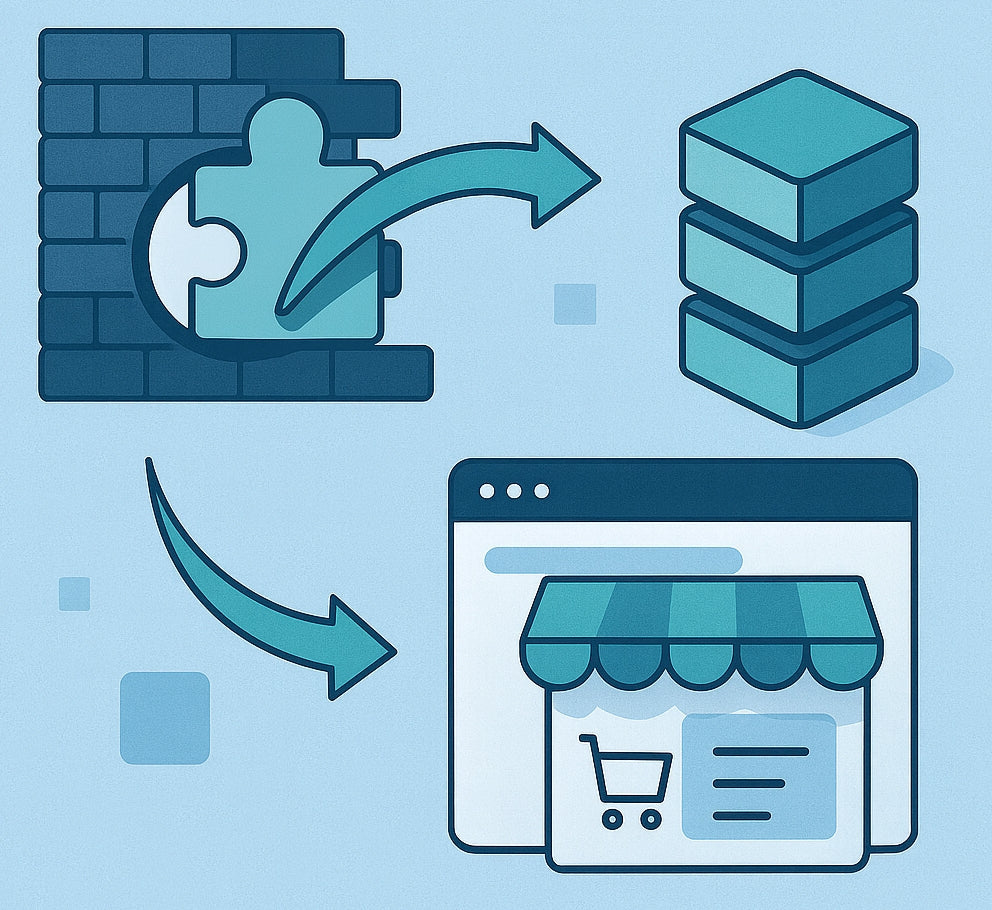Over the past two years, ecommerce brands have faced rapidly rising expectations: faster experiences, personalized journeys, real-time search, flexible checkout, intelligent merchandising, and seamless integration with dozens of marketing tools. At the same time, legacy platforms — some more than a decade old — have been unable to keep up.
A recent 2025 industry report from commercetools highlights this shift clearly: 88% of enterprises plan to modernize their commerce stack within the next 12 months, and 97% of leaders agree that AI-powered commerce will reshape customer expectations. Yet most organizations admit their current platforms are not ready for that future.
This is the new reality:
Replatforming is no longer a technical upgrade — it’s a business-critical investment.
Why AI suddenly accelerates the need for replatforming
Five years ago, brands migrated because of performance issues or outdated CMS features. In 2025, the drivers are fundamentally different:
1. AI requires flexible, modular architectures
Traditional monolithic platforms limit how brands can integrate AI for search, recommendations, content generation, pricing, or logistics. Every integration becomes a custom project.
Modern headless or composable platforms provide:
-
API-first integrations
-
Real-time data exchange
-
Freedom to adopt the best AI tools, instead of relying on built-in, limited features
This matters because generative and predictive AI are becoming the default shoppers expect, from product discovery to post-purchase support.
2. Customers now expect experiences that monolithic platforms struggle to deliver
Instant filtering, personal product feeds, conversational search, localized merchandising — these require:
-
lightweight front-end frameworks
-
scalable cloud infrastructure
-
independent microservices
If the entire platform needs to reload just to update a price or render a category page, you're competing with both hands tied.
3. Integrations are becoming too expensive on outdated systems
Many ecommerce teams spend more on maintaining legacy systems than on growth initiatives. Every new tool (ERP, PIM, CRM, AI search, OMS) takes months to integrate.
Modernizing the stack shifts the cost structure from “maintain and patch” to “build and optimize.”
Emerging migration patterns in 2025
The market is showing clear movement in three directions:
1. From legacy monoliths → to composable commerce
Brands moving away from older versions of Magento, Salesforce Commerce Cloud, and custom-built PHP platforms are choosing modular ecosystems where each service can evolve independently.
2. From traditional SaaS → to headless variants
Even Shopify merchants are increasingly adopting Shopify’s headless capabilities when they outgrow theme limitations and need more control over CX.
3. From multiple disjointed systems → to unified, API-driven architectures
ERP, PIM, OMS, checkout, loyalty, and content systems now operate as a connected network rather than isolated tools.
What drives replatforming decisions in 2025
1. Performance and reliability at scale
High-traffic brands need uptime even during flash sales. Composable and cloud-native platforms offer more predictable autoscaling and faster recovery.
2. International expansion
Multi-storefront, multi-currency, multi-warehouse operations require flexible catalog and order management — often not available in older systems.
3. Security and compliance expectations
Regulations evolve faster than legacy platforms can support. Brands increasingly migrate to reduce risk and ensure long-term compliance.
4. Faster experimentation cycles
Agile businesses want to ship changes weekly — not quarterly. Headless and API-first setups inherently support rapid iteration.
Why many replatforming projects fail — and how to avoid it
Replatforming is not trivial. Many organizations struggle because they:
-
attempt to replicate legacy systems instead of improving them
-
underestimate data migration complexity
-
choose too many vendors too quickly
-
skip the discovery and architecture blueprint stage
-
fail to build a phased rollout plan
The businesses that succeed tend to follow a structured roadmap:
1. Define the business case
Instead of focusing on features, start with measurable outcomes:
-
conversion rate improvements
-
operational cost reduction
-
time-to-market acceleration
-
expansion into new markets
-
AI adoption
2. Map the current and future state architecture
Identify what stays, what needs replacement, and what becomes microservices.
This avoids over-engineering.
3. Choose platforms that complement your current strengths
There is no single best platform. The right choice depends on:
-
catalog complexity
-
operational scale
-
need for custom workflows
-
in-house technical expertise
-
omnichannel requirements
4. Deliver in phases
A phased approach — catalog → checkout → CMS → search — reduces risk and allows early wins.
How AI is reshaping commerce platforms themselves
Platforms are evolving to become orchestration layers rather than all-in-one systems. This shift is driven by:
AI-powered search & discovery
Solutions like semantic search, vector indexing, and real-time product ranking require modern infrastructure.
Agentic commerce
By 2026, a significant portion of shopping decisions will be influenced by AI buying assistants and comparison bots. Brands need:
-
structured product data
-
fast APIs
-
transparent shipping & return policies
-
consistent pricing data
Legacy platforms were never built with this ecosystem in mind.
Automated merchandising & personalization
AI models can generate category pages, product bundles, or personalized storefronts, but only if the platform:
-
exposes real-time data
supports fast rendering on the front end -
allows content and commerce to be decoupled
Who should consider replatforming in 2025
Replatforming makes sense if your business experiences at least two of these problems:
-
declining site speed despite optimizations
-
rising cost of integrations
-
inability to support AI tools
-
difficulty managing multiple storefronts
-
checkout friction or increasing abandonment
-
limited control over the front-end experience
-
frequent incidents or downtime
-
outdated hosting or security limitations
-
slow release cycles (weeks or months per update)
If any of these describe your current situation, delaying modernization will only compound costs and create competitive disadvantages.
A realistic timeline for modernizing your commerce stack
Most mid-size and enterprise brands complete replatforming in 6–14 months, depending on:
-
catalog size
-
internal development capacity
-
need for custom UX
-
whether PIM/ERP integrations need rewriting
But an incremental rollout often provides business value as early as month 3 or 4.
The business case for acting now
The commercetools report makes one message unmistakably clear:
Brands that modernize their commerce stack grow faster, innovate faster, and adopt AI tools with significantly lower cost and risk.
The question in 2025 is no longer “Should we replatform?”
The real question is “Can our current platform support where the market is heading?”
For many retailers, the answer is increasingly “no.”
Modernizing your stack is ultimately about:
-
protecting future revenue
-
lowering technical debt
-
enabling AI-driven experiences
-
building resilience and scalability
-
giving teams freedom to innovate
And as more competitors replatform, standing still becomes the highest risk of all.


